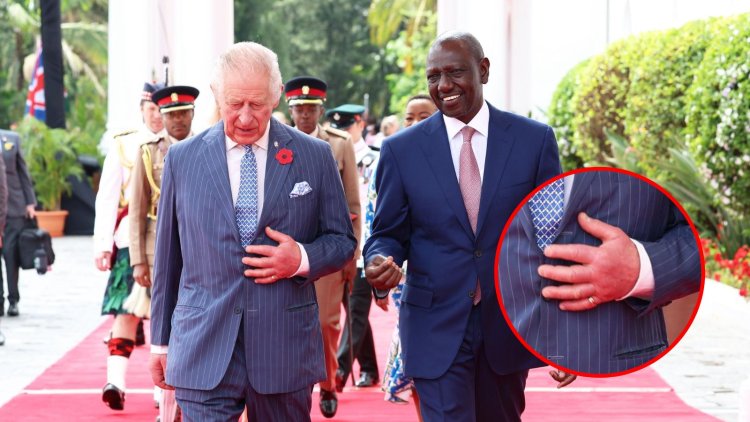Hidden Story Of Ring Worn On King Charles III's Little Finger
What Kenyans however observed from photos of the State House meeting was the ring that King Charles wore on his little finger

King Charles III and Queen Camilla were received by President William Ruto and First Lady Rachel Ruto at State House on Tuesday morning, October 31.
The Royal Couple were honoured with a 21-gun salute at State House after they arrived in the country on Monday night, October 30.
The procession then proceeded to Uhuru Gardens where King Charles was scheduled to lay a wreath at the Tomb of the Unknown Warrior. The King was also scheduled to visit the site where Kenya declared her independence.
What Kenyans however observed from photos of the State House meeting was the ring that King Charles wore on his little finger, a ring which he has been photographed wearing for years.

President William Ruto and First Lady, Rachel Ruto receive King Charles III and Queen Camilla at State House, Nairobi on October 31, 2023. /X
Viral Tea established that the ring he has been wearing is a signet ring. For thousands of years, men of influence have been donning a wearable form of identification and communication, which the ring represents.
Today, this remarkable ring is a common style accessory that can be worn by any gentleman, with some containing a flat face or fancy engravings on it of something like a heraldic beast, a family coat of arms, or a similar symbol.
According to Gentleman's Gazette, for wealthy and important men, a signet ring was a powerful tool akin to a signature: the engravings on the ring were unique to the man who wore it, and if he used the face of the ring like a seal, he could stamp his symbol into ink, wax, clay, or similar surfaces, and in doing so leave a mark similar to the way that we sign documents today.
A signet ring differs from other rings because of its engraved or raised symbol, series of words or letters, or image on the top half of the ring that is representative of its wearer in some way. It could be a name, initials, job title, rank, organization, or family crest.
Changes in how documents and correspondence are verified and safeguarded mean that signet rings are no longer needed as practical tools to verify or secure documents. It however remains one of the most common types of rings in menswear, thanks in no small part to its unique and fascinating history.
Signet Ring In History
The origins of the signet ring can be traced back to around 3500 BC and the Mesopotamian civilization. To seal and authenticate documents, Mesopotamians would use a rolling seal, similar to a stamp.
This cylindrical device was rolled across wet clay, leaving a distinct impression on it. Clay seals marked in this way were used to seal a variety of important items, including documents and packages for security and identification, as well as jars and containers to prevent tampering.
Because cylindrical seals were relatively difficult to carry around, the Mesopotamians made them more portable by placing the sealing elements onto rings. Not only were rings easier to carry around, allowing the seal to be literally on hand when needed, but they were also more secure: a ring could be worn on one’s person at all times to reduce the likelihood of misplacing the valuable seal or having it stolen.
Many great ancient civilizations employed signet rings in one form or another. In Ancient Egypt, pharaohs, religious leaders, and nobles would wear rings made of stone or a unique glazed pottery type called faience. The rings were flat on the outside and ornately decorated with hieroglyphics used to denote their owner.
During the Early Minoan Age, from roughly 2900 to 2100 BC, signet rings were commonly chiselled out of stone or ivory. Within a few centuries, signet rings were made out of metal and closely resembled modern signet rings.

A man wearing a signet ring. /SILVERY
Signet rings appear in the Bible and Torah, most prominently in the Book of Daniel, which is set around the 6th century BC. When King Darius ordered that Daniel be thrown into a den of lions, a stone was placed over the den, and it was marked with a seal from the signet ring of Darius and his nobles.
Sealing the stone in this way illustrated that Daniel’s punishment was done under the king’s authority and could indicate whether or not anyone had broken the seal to move the stone.
During the Hellenistic Period in Greece and the Early Roman Republic, signet rings continued to be used as official seals, but they also began to take on a more decorative role, with an increasing emphasis on crafting rings that were beautiful to behold and helped to illustrate the wealth and power of their owner.
These signet rings had additional decoration, in the form of gemstones or scrollwork, that appeared on the rings in addition to the faces of the actual seal. While still functional, these signet rings were increasingly viewed as luxury items.
Signet Rings As Security Seals
Historically, signet rings also played a significant role in business and politics. Functioning as a seal, a gentleman would use his ring featuring his unique family crest, emblem, or monogram to stamp important documents.
By dipping the ring into hot wax or soft clay, the ring left a distinct seal that was considered, at the time, to be more official than that of a signature, and this impression helped to solidify the authenticity of the sealed document. For this reason, signet rings are sometimes referred to as seal rings.
The wax or clay into which the impression was made was often placed in such a way as to effectively seal the documents or items on which they were impressed: for instance, over the flaps of a letter.
If someone tampered with the item, they would have to literally break the seal, and because they did not have access to the original ring used to seal the item with an impression, they could not replicate the original seal and, therefore, could not hide the fact that the item had been opened.
In this way, signet rings and seals could be used almost like a security device, making it clear whether or not someone had tampered with an item or read a private letter. This functionality was one of the reasons signet rings were so valuable and of such monumental importance.
King Charles III's Signet Ring
For King Charles, he is believed to have worn the ring since the mid-70s, and as fits a royal, the band is made of gold. Believed to be over 175 years old, the ring dates back to Queen Victoria’s reign over Great Britain.
Mostly worn on the little (pinky) finger of the less-dominant hand, King Charles has sometimes worn his signet ring on his ring finger, together with his wedding band.
King Charles’ signet ring has the official crest of the Prince of Wales, a node to the title he held before becoming the reigning monarch. Prince William, the current Prince of Wales and heir to the throne, also adorns a signet ring.
Recently, signet rings have also been embraced by women, with royals like the late Princess Diana and Kate Middleton, the Duchess of Cambridge, spotted adorning the rings.


 admin
admin 




